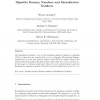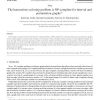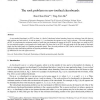275 search results - page 5 / 55 » Bounding the Number of Edges in Permutation Graphs |
DM
2000
13 years 7 months ago
2000
The Zarankiewicz number z(s, m) is the maximum number of edges in a subgraph of K(s, s) that does not contain K(m, m) as a subgraph. The bipartite Ramsey number b(m, n) is the lea...
DAM
2007
13 years 7 months ago
2007
In this paper, we prove that the harmonious coloring problem is NP-complete for connected interval and permutation graphs. Given a simple graph G, a harmonious coloring of G is a ...
SODA
2010
ACM
14 years 4 months ago
2010
ACM
The crossing number of a graph is the least number of pairwise edge crossings in a drawing of the graph in the plane. We provide an O(n log n) time constant factor approximation al...
APPML
2008
13 years 7 months ago
2008
A saw-toothed chessboard, or STC for short, is a kind of chessboard whose boundary forms two staircases from left down to right without any hole inside it. A rook at square (i, j)...
COMBINATORICS
2006
13 years 7 months ago
2006
We consider the problem of permutation reconstruction, which is a variant of graph reconstruction. Given a permutation p of length n, we delete k of its entries in each possible w...



